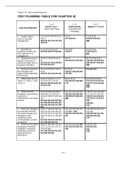Chapter 10 - Motivating Employees
TEST PLANNING TABLE FOR CHAPTER 10
LL:1 LL:2 LL:3
Knows Basic Understands Applies Principles
Learning Objective
Terms and Facts Concepts and
Principles
1. Explain Taylor’s 1,2,3,4,5,6,7,8,9,10,11,12, 15,16, 17,18,19,20,
theory of scientific 13,14, 197,198,199 200,201,202,203,
management. 189,190,191,192,193,194, 366
195,196
2. Describe the 21,22,23,24,25,26,27, 28,29,30, 31,32,33,34,
Hawthorne studies and 204,205,206,207,208,209 210,211 212,213,214,
their significance to 367
management.
3. Identify the levels of 35,36,37,38,39,40,41,42, 44,45, 46,47,48,49,50,51,
Maslow’s hierarchy of 43, 225,226,227,228,229 230,231,232,233,234,
needs and apply them to 215,216,217,218,219,220, 235,236,237,238,239,
employee motivation. 221,222,223,224 368
4. Distinguish between 52,53,54,55,56,57,58,59, 62,63,64, 253,254,255
the motivators and 60,61, 246,247,248,249,250,
hygiene factors identified 240,241,242,243,244,245 251,252
by Herzberg.
5. Differentiate among 65,66,67,68,69,70,71,72, 80,81,82,83, 84,85,86,87,88,89,
Theory X, Theory Y, and 73,74,75,76,77,78,79, 264,265,267,268,269, 271,272,273,274,275,
Theory Z. 256,257,258,259,260,261, 270 276,277,278,279,280,
262,263,264 369,
373*
6. Explain the key 90,91,92,93,94,95,96,97, 111,112,113,114,115, 116,117,118,119,120,
principles of goal-setting, 98,99,100,101,102,103, 300,301,302,303,304, 121,122,123,124,125,
expectancy, 104,105,106,107,108,109, 305,306,307,308,309, 310,311,312,313,314,
reinforcement, and equity 110, 389 315,316,317,318,319,
theories. 281,282,283,284,285,286, 320,
287,288,289,290,291,292, 370,271,
293,294,295,296,297,298, 375*
299
7. Show how managers 126,127,128,129,130,131, 151,152,153,154,155, 159,160,161,162,163,
put motivation theories 132,133,134,135,136,137, 156,157~,158~, 164,165,
into action through such 138,139,140,141,142,143, 332,333,334,335,336, 338,339,340,341,342,
strategies as job 144,145,146,147,148,149, 337 343,344,345,346,
enrichment, open 150, 374*
communication, and job 321,322,323,324,325,326,
recognition. 327,328,329,330,331
8. Show how managers 166,167,168,169,170,171, 181,182,183,184,185~, 186,187,188,
personalize motivation 172,173,174,175,176,177, 357,358,359,360,361, 363,364,365,
strategies to appeal to 178,179,180, 362 372,
employees across the 347,348,349,350,351,352, 376*
globe and across 353,354,355,356
generations.
10-1
,Chapter 10 - Motivating Employees
Total number of test items: 376
True/false questions are in plain text.
Multiple choice questions are in bold text.
Questions on boxed material are in bold text with a tilde~.
Essay questions are in bold underlined text.
Minicase questions are in bold with an asterisk*.
10-2
,Chapter 10 - Motivating Employees
Chapter 10
Motivating Employees Answer Key
True / False Questions
1. The sense of satisfaction you get when you achieve an important goal is an intrinsic
reward.
Answer: True
AACSB: Reflective Thinking
Bloom’s: Remember
Learning Objective: 10-01 Explain Taylor’s theory of scientific management
Level of Difficulty: 1 Easy
Topic: Motivating Employees
2. Extrinsic rewards are those that are given to a person by someone else.
Answer: True
AACSB: Reflective Thinking
Bloom’s: Remember
Learning Objective: 10-01 Explain Taylor’s theory of scientific management
Level of Difficulty: 1 Easy
Topic: Motivating Employees
3. Since motivation comes from within an individual, there is little that managers can do to
help motivate employees.
Answer: False
AACSB: Reflective Thinking
Bloom’s: Remember
Learning Objective: 10-01 Explain Taylor’s theory of scientific management
Level of Difficulty: 1 Easy
Topic: Motivating Employees
4. When unhappy employees leave a company, the firm normally ends up benefiting
financially.
Answer: False
AACSB: Reflective Thinking
Bloom’s: Remember
Learning Objective: 10-01 Explain Taylor’s theory of scientific management
Level of Difficulty: 1 Easy
Topic: Motivating Employees
10-3
, Chapter 10 - Motivating Employees
5. Frederick Taylor's goal was to find ways to improve worker motivation by making work
more interesting and challenging.
Answer: False
AACSB: Reflective Thinking
Bloom’s: Remember
Learning Objective: 10-01 Explain Taylor’s theory of scientific management
Level of Difficulty: 1 Easy
Topic: Motivation Theories
6. A key element of Frederick Taylor's approach was the time-motion study, which examined
the tasks performed to complete a job and the time needed to complete each task.
Answer: True
AACSB: Reflective Thinking
Bloom’s: Remember
Learning Objective: 10-01 Explain Taylor’s theory of scientific management
Level of Difficulty: 1 Easy
Topic: Motivation Theories
7. Frederick Taylor based his approach on the belief that each worker was an individual who
should be treated as a unique asset to the firm.
Answer: False
AACSB: Reflective Thinking
Bloom’s: Remember
Learning Objective: 10-01 Explain Taylor’s theory of scientific management
Level of Difficulty: 1 Easy
Topic: Motivation Theories
8. Scientific management became the dominant strategy for improving productivity during
the early 1900s.
Answer: True
AACSB: Reflective Thinking
Bloom’s: Remember
Learning Objective: 10-01 Explain Taylor’s theory of scientific management
Level of Difficulty: 1 Easy
Topic: Motivation Theories
9. Elton Mayo conducted studies know as the Hawthorne Studies and became known as the
father of scientific management.
Answer: False
AACSB: Reflective Thinking
Bloom’s: Remember
Learning Objective: 10-01 Explain Taylor’s theory of scientific management
Level of Difficulty: 1 Easy
Topic: Motivation Theories
10-4




